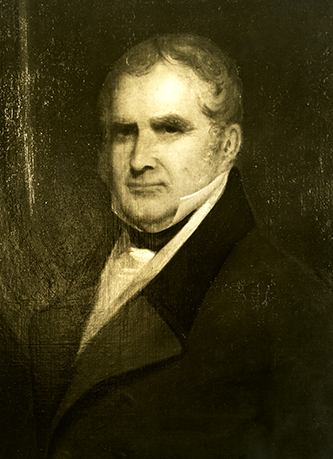ca. 1766–26 Oct. 1833

Peter Browne, counselor at law, was a native of Knockadock in Aberdeenshire, Scotland. He came to America at an early age, destitute of friends and fortune. There seem to be no records pertaining to his early life or formal education. For more than forty years, he was a citizen and resident of North Carolina. The rare endowments of his mind and the method that entered into his arrangements enabled him speedily to rise to eminence in the legal profession and accumulate great wealth. He pursued the practice of law in North Carolina in Windsor and next at Halifax. He was one of two patrons to whom Jonathan Price and John Strother dedicated their map of North Carolina, which appeared in an undated issue and later in one dated 1808. He represented Halifax County in the House of Commons in the General Assembly.
By 1814, Browne had removed his permanent residence to Raleigh, where he bought Wakefield, the colonial residence of the recently deceased Colonel Joel Lane, who figured prominently in the early history of Wake County and in the founding of Raleigh as the state capital. Before Raleigh was established in 1792, Lane's residence was the most important house in the area then known as Bloomsbury or Wake Crossroads. The county seat of Wake was originally Bloomsbury, and the deed for the site of Raleigh was negotiated at Wake Courthouse on Lane's plantation. Although Browne owned the Lane home and grounds only a few years, it was during this time that he damaged his reputation by an unforgettable deed. Finding the Lane burying ground, where the Lanes and many other early citizens were interred, an unprofitable piece of property, he had it plowed up and planted in cabbages. The desecrater was later described by one historian as an able lawyer but a miser and a utilitarian, respecting nothing above its value in dollars and cents.
Browne was listed on the 1814 Wake County Tax Lists as owning 296 acres and as the enslaver of three people. In 1818 he sold the Lane home and his well-selected library to William Boylan, Raleigh editor and businessman. With an ample fortune and high reputation, he retired from his professional pursuits in his fifties and returned to Scotland to spend his remaining years. After an absence of three years, he returned to the United States, relocated in Raleigh, and resumed his career. In 1821 he accepted the appointment of justice of the peace. He served several times as chairman of Wake County court and was known for deciding cases with unprecedented facility and dispatch: few and brief were the arguments in Wake County court in his day. His extended career in legal and professional capacities included leadership in advocacy of internal improvements and service as head of the bar.
For a number of years, Browne was one of the leading stockholders of the State Bank of North Carolina, which had its principal branch in Raleigh. After serving as director in 1830 and early 1831, he was unanimously elected president to succeed Duncan Cameron, who had resigned. Browne remained president until his death. He was unmarried and left no relatives in the United States to inherit his large fortune, but a nephew in Scotland inherited half a million dollars from the estate. In 1834 his stock was sold to the highest bidder at the door of the Bank of North Carolina by the administrator, William Boylan.
Although portions of Browne's life are unrecorded, and although he was called a desecrater, he was recognized in North Carolina as one of the great lawyers of his time, along with such men as Edmund Badger, Thomas Ruffin, and Duncan Cameron. He was buried in Raleigh's City Cemetery, where a stately monument was erected to him by his nephew, Robert Simpson of Scotland. The monument did not escape desecration: some years ago, a vandal with a knowledge of stonecutting added two figures to the inscription of his age, which now reads, "aged 6711 years." Still later, vandalism reduced the table-like monument to a slab on the ground.
Two portraits of Browne exist and hang in Hayes Plantation in Edenton. The artist of the original portrait and its history are unknown, but the second portrait was painted by Edward Caledon Bruce in 1859. Bruce evidently copied his portrait from the earlier one.